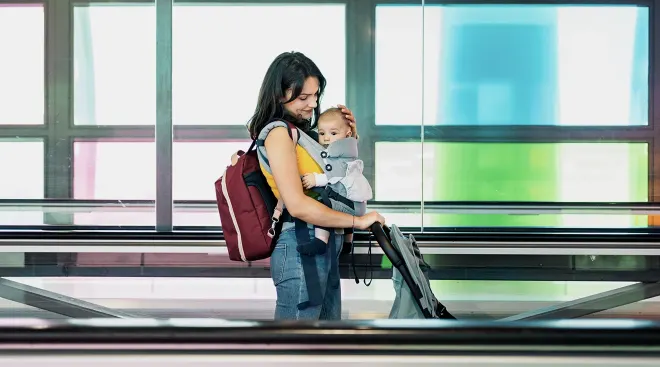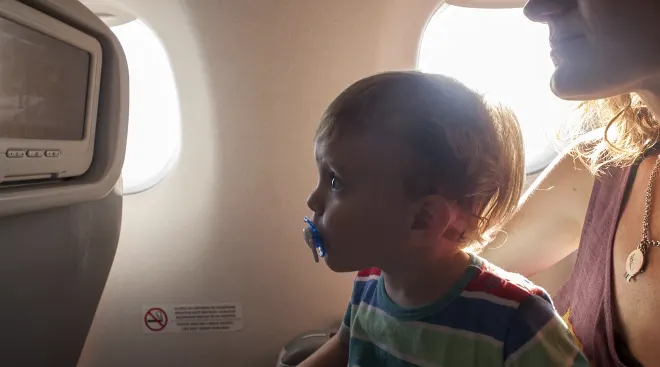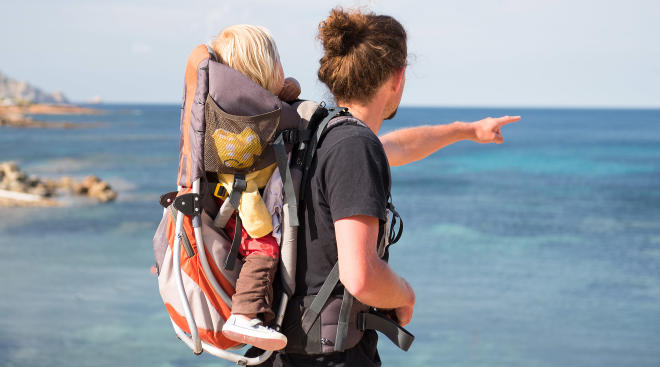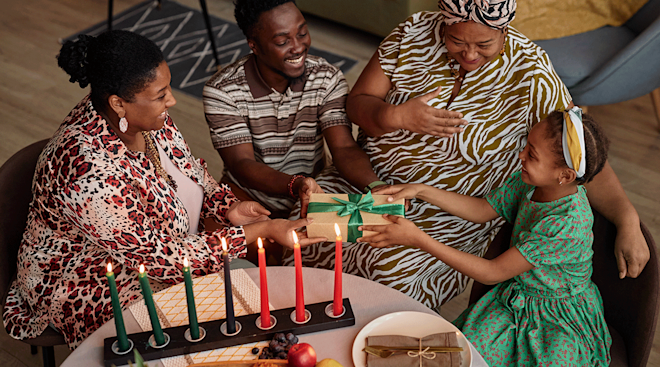The Best Babymoon Destinations (According to Real Parents)
Pregnancy is an exciting journey. But it can also be a super-busy and stressful period of life. From managing doctor appointments and filling out paperwork for parental leave to facing some rather unpleasant symptoms, you may be left feeling like you need a break for yourself and your partner.
Why not plan a vacation for just the two of you? That’s exactly what a babymoon is—a chance for you and your plus-one to get away together and reconnect before your family grows. Intrigued? You’ll be glad to know that lots of resorts and hotels offer fun extras for couples on a babymoon, from free massages to swag for baby. But before you book your dream babymoon destination, you’ll want to take some important travel factors into consideration. Read on for some important travel tips from real parents and a registered nurse, plus a roundup of our favorite babymoon destinations in the US and beyond.
A babymoon is a vacation a couple takes together before baby’s arrival, says Jacqueline King, APRN, FNP-BC, a nurse practitioner in South Florida. “It’s a great way for couples to connect and build excitement prior to the arrival of their newborn.”
Some couples choose to go all out for their babymoon, while others simply plan a low-key local trip or even a staycation. “As long as you take the proper precautions, a babymoon can be a time to relax, reminisce and anticipate this momentous occasion in your life,” says King.
The first decision you’ll be faced with: When is the best time to take a babymoon? You’ll want to talk to your ob-gyn or midwife about your overall health and when they think it’s safest for you to travel. Although some doctors may allow you to travel through week 36 of your pregnancy, King recommends traveling a bit earlier. “The best time to take a babymoon is at the end of your second trimester, around 28 to 30 weeks pregnant,” she says. “This is ideal timing, as pregnant women at this gestational age tend to have more sustained energy and improved general well-being without exhibiting a lot of more common symptoms seen later on, like swelling, fatigue, Braxton Hicks contractions and reflux.”
Before you jet off on your babymoon, there are some things you’ll want to consider to ensure a safe experience for both you and baby. So how do you choose the best location? Once you’ve considered the factors below, take a look at things like your budget, the time of year and whether you’re looking for something calm and quiet or urban and active.
-
Access to clean water. When considering your travel destination, you want to ensure that you have access to clean, running water as hydration in pregnancy is absolutely key, says King.
-
Medical care. Access to medical care at your babymoon destination is crucial when you’re expecting, King advises. “The first thing you must do is clear your travel dates and the destination with your provider by seeing them at regular intervals prior to your departure,” she says. Access to medical care at your given babymoon destination is also critical in case unforeseen issues arise that require you to be evaluated, King says. This can mean making sure there’s on-site care, like on a cruise ship, or researching proximity to a local hospital.
-
Travel vaccinations. “Vaccines may be necessary, depending on your destination, but you need to consult your provider first, as live virus vaccinations are not recommended during pregnancy, such as chickenpox or measles,” King says.
-
Unexpected pregnancy issues. Most doctors and midwives won’t let you fly beyond 35 to 36 weeks, due to the proximity to your due date and risk of going into labor. But if you’re on bedrest, pelvic rest or have experienced any other sort of pregnancy complications, you may be grounded earlier. If you’re traveling far, it may be a good idea to look into trip insurance in case you need to cancel. Better yet, consider a more local, drivable option.
-
Safety of your chosen destination. There are numerous tools you can use to determine if a destination is considered “safe” or not. According to King, the US Department of State’s Travel Advisories is a great tool you can utilize to assess everything from clean water to COVID-19 infection rates to local crime.
Ready to enjoy a few days of peace, quiet, sleep and adventure before your lives are turned upside down (in the best way imaginable)? Whether you’re looking for babymoon ideas on a budget (think: staycation!) or prefer an exotic international excursion, we’ve got you covered. Here’s our list of the best babymoon destinations for you and your partner, no matter what trimester you’re in.
Best winter babymoon destination
Searching for a winter getaway? This southern city has something for everyone! Of course, Charleston is worth a visit year round but it’s a standout winter destination thanks to the mild climate. Matthew and Amanda, who visited the city when they were 24 weeks pregnant, can attest to this: “With baby #3 on the way, we knew we needed a weekend to rest and relax. We chose Charleston for the perfect mix of food, culture, beaches and warmth in February.” And, as tourist crowds tend to thin out in the winter months, you may even score a deal on accommodation and flights. Spend the days relaxing poolside at one of the city’s many posh inns and hotels or strap on your comfiest walking shoes and crush your daily step count with a tour of this beautiful, historic babymoon destination. Can’t-miss sites include the iconic pineapple fountain located in Waterfront Park and some of the city’s well-known eateries, like Grill 225 or Amen Street Fish and Raw Bar (just be sure to skip any raw shellfish on the menu). With tons of upscale shopping and even a lively nightlife (if you aren’t exhausted by 8 p.m.), you can easily fill several days in Charleston.
"It was absolutely perfect! Our weekend was filled with grits, plantation walks, carriage rides and relaxing on the beach."
Best spring babymoon destination
Phoenix, Arizona is a top babymoon destination for culture-lovers and outdoor enthusiasts alike. Concerned about battling the desert heat? Don’t sweat it—April to November is the perfect time to visit as the weather cools off considerably. Shaheen and Trevor visited Phoenix for their babymoon and gave it a big thumbs up: “Arizona was perfect in April. It would be in the 50s and 60s when we went for breakfast and dinners, making it perfect to dine alfresco. With a ton of outdoor activities to enjoy, we stayed busy and also made sure to sneak in some pool time.” Relax poolside at one of the city’s luxurious swim resorts or brave a hike up Camelback Mountain, which is said to look like a kneeling camel and offers awe-inspiring panoramic views at the peak. Other cultural highlights include the Phoenix Art Museum, the Desert Botanical Garden and the Phoenix Zoo. When it comes to grub be sure to stop in at Pizzeria Blanco (as seen on the Netflix show Chef’s Table: Pizza) for a tasty slice.
"Aim for a short, direct flight and guaranteed warm weather. And check your destination’s weather calendar for your time frame! Although the heat in Arizona can be unbearable at certain times of year, it was perfect in April."
Best summer babymoon destination
When you choose Maui as a babymoon destination, you’ll arrive in paradise without even needing a passport. While we can’t think of a better place to take a babymoon, the flight is a bit lengthy no matter where you’re coming from. (That means you may want to consider taking your Maui babymoon a bit earlier in your pregnancy, to avoid swelling after a long plane ride.) Once in Maui, you’ll have your pick of luxury resorts offering massage services, fine dining and plenty of relaxation! Although battling pregnancy fatigue Christine enjoyed a relaxing babymoon with her partner in Maui: “I made the most of it on our trip by getting in the water all the time and taking naps whenever I felt like it. I’m not kidding: My second day in Maui, I slept for 12 hours. I paced myself with activities and had an incredible time.” If you do feel up for some adventure, take in the sunrise on Haleakala (dress warmly and definitely drive!) or go snorkeling at Molokini. And if you’re up for superb local cuisine, attend an evening luau for an experience you’ll never forget.
"I’m all about relaxing and I love adventure, and I think I gave myself a really happy medium with this trip."
Best fall babymoon destination
If you feel up for a European sojourn, this famous Italian city would be a perfect place for a romantic getaway. Our advice? Visit the famous floating city in the fall. The weather is cooler (Italian summers are notoriously hot) and there are fewer tourists filling up the winding streets. Once you arrive satisfy your pregnancy cravings with pasta, pizza and gelato, and of course, take a romantic gondola ride along the ancient canals. While there’s tons of sight-seeing opportunities, it’s also a great place to relax and unwind with your other half. For their babymoon, Kelli and Kyle planned a return trip to Venice, Italy: “We splurged and stayed at a hotel on its own separate island with views of Venice from across the water,” says Kelli. Of course, there are many fabulous places to stay in Venice including the world-renowned Baglioni Hotel Luna. It has deluxe rooms, serves decadent meals, boasts enticing cocktails and mocktails and has a spa that offers a body-melting one-hour massage (and other treatments) for moms-to-be. Pure luxury. “It is such a great excuse to reset, relax and see a part of the world that you’ve always wanted to. You can do as much as you want on your babymoon, or nothing at all," says Kelli. "It’s a great excuse to eat gelato, too!”
"We didn’t have anything planned and instead decided to just enjoy the romance of this beautiful city … we ordered room service, went to the pool, relaxed and enjoyed our time together; it was perfect."
Best low-key babymoon destination
There’s so many charming local attractions on Galveston Island, it’s no surprise that many couples head there for a relaxed babymoon vacation. Connected to mainland Texas by a causeway bridge, this quaint coastal resort is just an hour south of Houston, making it easily accessible for folks that prefer not to fly during pregnancy. Convenience was a big factor for Leah and Dustin who traveled to Galveston in the third trimester. “Choose a destination close to home—either a quick drive or quick flight—and easily walkable, with plenty of food options. You want to get out and explore but not tire yourself out. I got quite hungry while we were exploring and it was nice to have places to stop and grab a bite,” says Leah. Visit the Galveston Island Historic Pleasure Pier, which boasts roller coasters, carousel rides and fairground games—plus, tons of tasty food trucks and restaurants. Another cool spot is the Moody Gardens, a must-see destination that houses a spa, aquarium, golf course and more. Sea swimmers can go for a dip on one of the many beaches within walking distance of the promenade while antique hunters peruse the local boutiques. Or why not get dressed up and catch a show at The Grand 1894 Opera House? Whatever your interests may be there’s truly something for everyone in Galveston, Texas.
"During the day, we explored the island’s attractions, including shopping in the historic downtown, and having a date at the amusement park. We enjoyed a spa day, and I booked a prenatal ‘mommy-to-be’ massage. We also enjoyed dining throughout the island, but the best part was being able to retreat to our vacation house for sunset walks along the beach."
Best babymoon destination for romance
Next up on our list of the best babymoon destinations is the city of lights—aka Paris. France’s capital is a global center for art, food, fashion and culture, so you won’t be short of things to do here. Stroll through the arrondissements and admire the architecture, climb the Eiffel Tour, take a tour of the Louvre Museum or see the city by boat on a romantic evening cruise on the Seine. Trang and her husband Viet took a pre-planned trip to France at 26 weeks pregnant and soaked up everything the city had to offer: “One week in Paris was a good amount of time for us considering the best way to see the city is on foot. We walked and took public transportation everywhere.” There’s plenty of high-end and affordable accommodation options on offer, but if you really want to push the boat out consider Le Meurice, a five-star hotel located in the beating heart of the city.
"Our favorite meal of the day was definitely breakfast. Hot chocolate and a croissant is the way to go!"
Best adults-only babymoon destination
Looking for a luxurious babymoon destination? Head to one of the many kid-free resorts in Palm Springs. Known for its sunny climate, natural hot springs and midcentury-modern architecture, Palm Springs oozes luxury, making it the perfect spot for seasoned parents that need some grown-up time ahead of a new arrival. For their second pregnancy Jessie and Chris visited Sparrows Lodge, an adults-only hotel with all the small luxuries you could need. “I was two months from my due date and already pretty uncomfortable, so lying by or in the pool was such a treat. One morning, we borrowed bikes and took the bump exploring,” Jessie reminisces. Aside from biking or lounging poolside, visitors can do a stargazing tour at the nearby Joshua Tree National Park or relax in a private soaking tub at The Spa at Séc-He.
"Take the babymoon around your sixth month—you’re far enough into it to really need a break, but not too close to the due date to worry about traveling away from home."
Best scenic babymoon destination
Want to soak up the sights? The South of France is the ultimate babymoon destination. From the sparkling seaside resorts along the Cote d'Azur to the rolling lavender fields in Provence, this region has so much to offer. Expectant parents Diana and Steven flew to Bordeaux for a babymoon in the later stages of pregnancy. The couple explored local farmer’s markets and shopped for baby clothes, before renting a car and heading into the French countryside. “We stayed in a chateau in Dordogne and spent our days lounging at the pool and visiting castles and surrounding villages. We continued south towards Nice where we laid on rocks, swam in crystal clear water and ate a lot of pizza and gelato. We were fortunate enough to take a day trip to Monaco to catch the Formula One Grand Prix,” says Diana. History buffs should also plan a day trip to the Pont du Gard bridge, which is the tallest Roman aqueduct in the world and a UNESCO world heritage site to boot.
"Even though I might not have been able to see my toes or tie my shoes, going on trips through different cities encouraged me to walk and see new sights. (My motivation for walking was pastry and ice cream shops.)"
Best babymoon city break
Always dreamed of visiting the big apple? Plenty of people choose New York City as a babymoon destination. Leona surprised her partner Angie with a babymoon to New York for Valentine’s Day: “We decided we wanted to have an adventure before our baby came, so we rented an AirBnB within walking distance of Times Square and stayed with a local to get some insider tips. We spent four days taking in the sites and being complete tourists (we even did a hop on/hop off tour).” Once you’ve gotten the lay of the land, be sure to visit Manhattan’s iconic neighborhoods from the Upper East Side and SoHo to Herald Square. Look at the famous store windows at Bloomingdale’s, Bergdorf Goodman and Saks Fifth Avenue. And when you’re finished with your retail therapy, check out a Broadway show, head over to the Empire State Building or visit the Statue of Liberty. It’s no wonder they call it the city that never sleeps (but make sure you get some rest!).
"Make sure you take a babymoon. It will be the last trip you take as just a couple. Enjoy each other and soak it all up."
Best North African babymoon destination
Yearning for an exotic babymoon destination? Marrakesh is a cultural hotspot steeped in North African sunshine. While some people may be daunted by such a far-flung location, Jessie and Jake were drawn to the magic of Morocco. “It’s a destination rich in history—and ridiculously photogenic. Whether it was the traditional guesthouse, glamping in the Agafay desert or staying at luxurious private residences, Morocco left us feeling relaxed, inspired and excited to welcome our newest addition into the world,” explains Jessie. Spend time haggling for a deal in the souks (traditional open-air markets), relax poolside at one of the city’s many spas or sample the local cuisine.
"There’s something just a little bit magical about Morocco … the climate fit my overwhelming desire to sit in the sun and do nothing but relax."
Best beach babymoon destination
Fancy a babymoon at the beach? Florida is home to many stunning coastal destinations, including Seacrest Beach. Known for its sugar-white sand and turquoise waters, Seacrest is just as beautiful as an exotic resort but has a relaxed low-key vibe. This setting was perfect for Victoria and Ian. “We both knew that the next few months of our lives were going to be so hectic that we needed to slow down a bit,” says Victoria. “We splurged on nicer restaurants and stayed up way past our normal bedtime. There were lots of cute shops, restaurants and places to go have a cup of coffee together,” she continues. Spend a day swimming and sunbathing on the beach or rent bikes and tackle the Timpoochee Trail. When it comes time to refuel, head to George's at Alys Beach or check out Seacrest Sundries, a local mom-and-pop cafe and grocery store.
"Soak up every single minute you can with each other, because I had no idea how hard it would be to get that time after the baby. And make sure to splurge on yourself a little. It will be harder to do those things after."
We get it—picking a babymoon destination takes a lot of forethought and planning. To streamline your decision-making process, our goal is to do the bulk of the research for you, so you don’t have to spend hours researching domestic and international locations. We do this by considering a list of criteria when sourcing babymoon hotspots, including transport options, tourist attractions, weather and, last but definitely not least, safety. This way you can count on having a relaxing vacation wherever you are.
To decide which babymoon destinations are best, we chatted with expectant parents to gain invaluable travel tips and spoke to a registered nurse to understand the key safety considerations for travel while pregnant.
Interested in learning more about our editorial process? Read about how our team develops and reviews all articles here.
Plus, more from The Bump:
Jacqueline King, APRN, FNP-BC, is a nurse practitioner in South Florida.
Navigate forward to interact with the calendar and select a date. Press the question mark key to get the keyboard shortcuts for changing dates.
































































